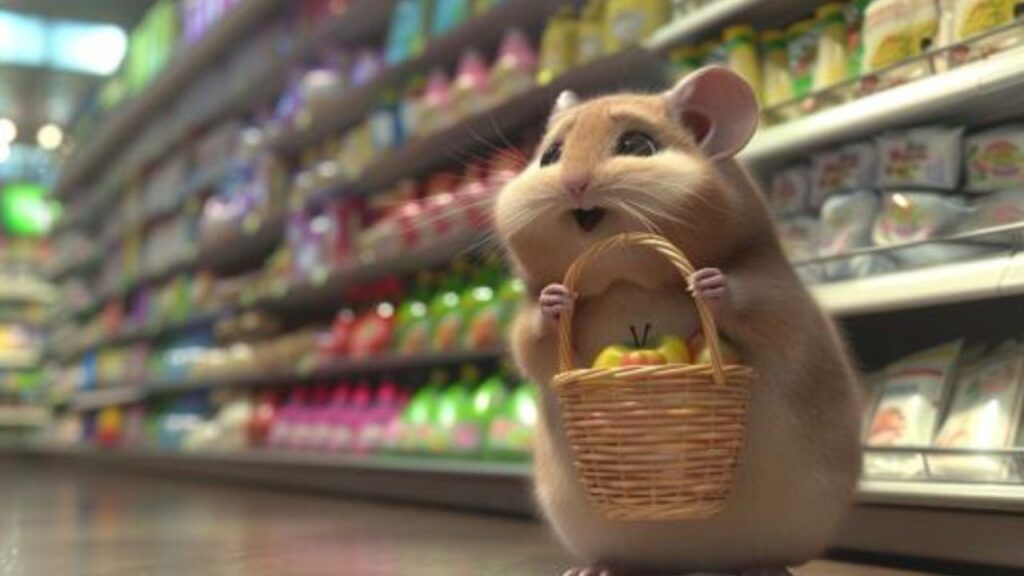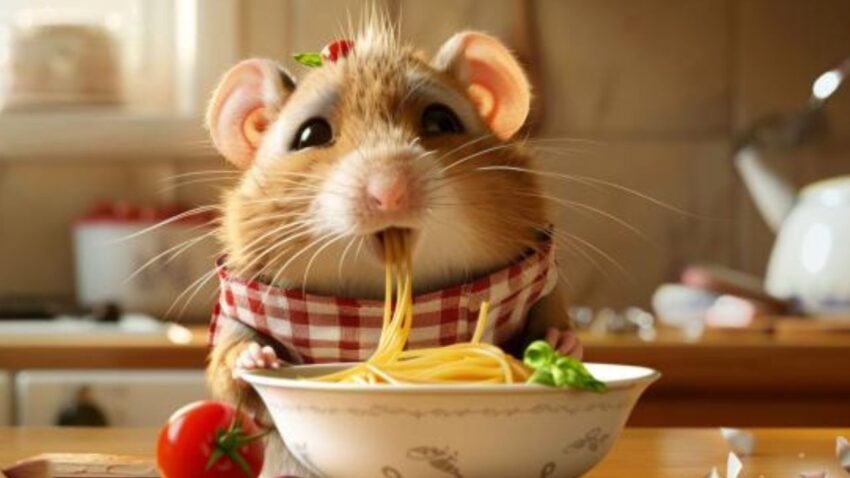When picturing a hamster in its natural habitat, you might imagine a small, furry creature foraging through a variety of seeds, grains, and the occasional insect or fruit. This image is quite accurate and provides a stark contrast to the image of a domestic hamster contemplating a strand of spaghetti. Understanding the natural diet of hamsters is the first step to ensuring their health and happiness in captivity.
Hamster Diets: A Wild Perspective
In the wild, hamsters are opportunistic omnivores. Their diet primarily consists of a variety of grains, seeds, and nuts, which provide them with a stable supply of energy. They also indulge in protein sources such as insects and even small lizards or frogs, which are crucial for their growth and development. To supplement their diet, wild hamsters consume a range of fruits and vegetables, which offer essential vitamins and minerals, as well as a needed moisture content.
The wild hamster’s diet is a balancing act, naturally designed to meet their nutritional needs, which include a high fiber intake for digestive health, protein for body maintenance and repair, and a minimal amount of fats for energy.
Nutritional Needs in Captivity
When hamsters turn the wheels of their life in the comfort of our homes, their diets shift dramatically. Domestic hamsters rely on their human caretakers to mimic the nutritional balance they would find in their natural habitat. The cornerstone of a pet hamster’s diet is a well-formulated hamster mix, which typically contains a blend of seeds, grains, pellets, and dried vegetables. These mixes are crafted to provide a balanced intake of nutrients, mirroring the variety they would have access to in the wild.
However, the diet of a captive hamster shouldn’t end with commercial food mixes. Fresh fruits and vegetables should be introduced to provide the diversity and nutritional complexity needed for optimal health. Items like apples, pears, broccoli, and spinach can be excellent additions, but they should be offered in moderation due to their sugar and water content, which in excess can lead to health issues such as diarrhea.
Protein is another pivotal aspect of a hamster’s diet, often overlooked in captivity. While the hamster mix contains some level of protein, offering a small amount of cooked lean chicken, hard-boiled eggs, or mealworms can significantly benefit their dietary needs, especially for pregnant or nursing females.
It’s important to note that hamster diets also vary between species, with some requiring more protein or different nutrient balances than others. Additionally, hamsters are hoarders by nature, often storing food in their cheek pouches and in corners of their enclosure. Regularly cleaning out these stashes can prevent the consumption of spoiled food and maintain a healthy dietary cycle.
Understanding and replicating the balance of nutrients found in a hamster’s natural diet are key to a happy and healthy pet. With the right mix of commercial food, fresh produce, and protein sources, your hamster’s nutritional needs can be fully met, without the need for human food treats like spaghetti. After all, a hamster’s health is not just measured in seeds and grains, but in the careful consideration of its entire diet.
Spaghetti and Hamsters: A Possible Combination?

When we think of spaghetti, it often conjures up images of a hearty meal shared with family and friends, not with our pet hamsters. Yet, the curiosity about whether this staple of human cuisine can cross species boundaries is a valid one. Let’s unravel the ingredients of spaghetti and assess their compatibility with a hamster’s dietary needs.
Assessing the Ingredients of Spaghetti
Spaghetti, at its core, is made from wheat flour and water, sometimes enriched with vitamins and minerals for added nutritional value in humans. While these ingredients may seem harmless, they are not a natural part of a hamster’s diet.
Firstly, the wheat in spaghetti is a source of gluten, which is a protein that hamsters do not normally encounter in their natural foraging. Gluten can be difficult for hamsters to digest and may lead to gastrointestinal issues. Moreover, the refined flour in spaghetti is high in carbohydrates and offers little nutritional value to a hamster, who requires a diet high in fiber to maintain proper digestive function.
Secondly, spaghetti served to humans often contains various additives, such as salt, which is harmful to hamsters in large quantities. High sodium intake in hamsters can lead to dehydration, kidney strain, and other health issues. Other common ingredients in spaghetti dishes, like garlic and onions, are toxic to hamsters and can cause blood disorders and digestive upset.
Potential Health Concerns for Hamsters Eating Spaghetti
Beyond the basic ingredients, there are several health concerns to consider before allowing a nibble of noodle to reach your hamster’s bowl:
Risk of Obesity and Diabetes
Spaghetti is calorie-dense and can lead to obesity in hamsters if fed inappropriately. Obesity in hamsters is a serious concern and can be a contributing factor to diabetes, a condition to which some hamster species are particularly prone.
Gastrointestinal Distress
The complex carbohydrates in pasta may be difficult for hamsters to break down, leading to bloating, gas, and diarrhea. These digestive issues are not only uncomfortable for your pet but can also lead to more serious health problems if persistent.
Nutritional Imbalance
Feeding spaghetti to hamsters can disrupt their nutritional balance. Hamsters need a variety of nutrients in specific ratios, and spaghetti does not fit within this regimen. A diet high in pasta could displace other essential nutrients, leading to deficiencies.
In conclusion, while spaghetti may seem like a fun and harmless treat for your hamster, the reality is that it’s fraught with potential health risks. The ingredients and preparation of spaghetti are not in harmony with a hamster’s dietary needs. As appealing as it might be to share your favorite meal with your pet, it’s essential to stick to foods that are beneficial to their health.
Safe Foods for Hamsters: Nourishing Alternatives to Spaghetti

While spaghetti might be off the menu for your hamster, there’s no need for their dining experience to be bland. There is an abundance of safe and healthy alternatives that can not only satisfy your hamster’s palate but also provide them with the nutrition they need to thrive. Let’s explore some wholesome options to keep your hamster’s meals exciting and nutritious.
Nutrient-Rich Substitutes for Spaghetti
Fresh Vegetables
Vegetables are a cornerstone of a healthy hamster diet. Offer a variety of greens such as kale, spinach, and broccoli, which are rich in vitamins and minerals. These veggies are high in fiber and low in calories, making them an excellent choice for maintaining a healthy digestive system, unlike spaghetti, which is high in carbohydrates and low in fiber.
Whole Grains
Instead of processed wheat pasta, opt for whole grains like brown rice, barley, or oatmeal. These grains provide essential B vitamins and are an excellent source of fiber, contributing to a well-functioning digestive tract. They are more similar to what hamsters would naturally forage for and are a healthier complex carbohydrate source than refined pasta.
Cooked Legumes
Beans and lentils, when cooked and offered in moderation, can be a good source of protein for hamsters. Unlike the gluten proteins in spaghetti, the proteins in legumes are more suitable for a hamster’s dietary needs. They also contain fiber and other nutrients beneficial for your pet’s overall health.
Fruits in Moderation
Small amounts of fruit can be a sweet treat for your hamster, providing them with natural sugars and vitamins. However, fruits should be given sparingly due to their high sugar content. Options like apples (without the seeds), blueberries, and melon can be offered occasionally as a healthy alternative to sugary human desserts.
Comparing Nutritional Value with Spaghetti
When comparing these hamster-safe foods to spaghetti, there are several key nutritional differences to consider:
- Fiber Content: The alternatives listed are generally higher in fiber than spaghetti, which is important for a hamster’s digestive health.
- Protein Quality: The protein from legumes is more suitable for hamsters than the gluten found in pasta.
- Sugar Content: While fruits do contain sugars, they are natural and accompanied by important vitamins and antioxidants, unlike the simple carbohydrates in pasta that offer little beyond calories.
- Vitamin and Mineral Profile: Fresh vegetables and whole grains provide a spectrum of essential nutrients that spaghetti cannot match, including vitamin C, which is crucial for some hamster species.
In essence, the alternatives to spaghetti offer a balanced approach to a hamster’s diet, providing various nutrients without the empty calories and potential health risks associated with pasta. By choosing these healthier options, you can create a diet for your hamster that is both diverse and nutritionally complete, contributing to their well-being and longevity.
Whisker Tips: Feeding Your Hamster Right

When it comes to pampering your petite pet with a banquet of healthy options, the transition to new foods should be as smooth as their fur. Introducing new elements to your hamster’s diet can be a delightful adventure for their taste buds but must be done with care. Here’s some practical advice to ensure that your hamster can navigate the buffet of safe foods without any bellyache bumps along the way.
Introducing New Foods Gradually
Hamsters have sensitive digestive systems, so when you introduce a new food, do it in tiny amounts. A piece of vegetable or fruit the size of a sunflower seed is plenty for the first serving. This allows you to monitor their reaction to the new food over the next 24 hours.
Observe for Any Adverse Reactions
After offering a new food, watch for any changes in your hamster’s behavior or stool. Diarrhea or lethargy can be a sign of an adverse reaction to the food. If you notice any negative symptoms, remove the new food from the diet and consult with a vet if necessary.
Mix New Foods with Old Favorites
To make the transition smoother, mix the new food with some of the foods your hamster already enjoys and tolerates well. This can make the new food seem less intimidating and more appealing.
The Importance of Moderation
Even healthy foods can cause problems if fed in excess. Stick to small quantities, especially with fruits that are high in sugar or any food high in protein and fat. Moderation is key to maintaining a balanced diet and preventing obesity and other health issues.
Rotate Different Foods
Variety is not just the spice of life; it’s the cornerstone of a well-rounded hamster diet. Rotating different safe foods throughout the week ensures a wide range of nutrients and keeps mealtime interesting for your hamster.
Maintaining a Balanced Diet
While fresh foods are an important supplement to a hamster’s diet, the bulk of their nutrition should come from a high-quality hamster mix that is formulated to meet their needs. Fresh foods are the cherry on top, not the main course.
Avoid Overfeeding Treats
Treats should be given sparingly and should not exceed 10% of your hamster’s total diet. This helps prevent selective feeding, where a hamster may choose only the high-fat or sugary treats and ignore their staple food.
Hydration is Vital
With the introduction of new foods, especially dry ones like grains, make sure your hamster always has access to fresh water to aid in digestion and overall hydration.
By following these “Whisker Tips,” you’re setting the table for a dietary regime that’s as nutritious as it is delicious for your hamster. Remember that every hamster is an individual with its own tastes and tolerances, so what works for one may not work for another. Keep a close eye on how your hamster responds to new additions, and adjust as needed.
Feeding your hamster right isn’t just about the individual meals; it’s about creating a consistent pattern of diverse, balanced, and moderate feeding that supports their health in the long term. After all, the goal is to keep those little whiskers twitching with joy at mealtime.
Conclusion: Noodling Up the Hamster Diet Facts

As we’ve twirled through the details, it’s become clear that spaghetti, despite its charm on our plates, does not spin the same magic in a hamster’s diet. The key takeaway is that while it’s tempting to share our human foods with our furry friends, their health and dietary needs are vastly different from ours.
To recap the main points:
- The ingredients in spaghetti, including wheat flour and often salt, are not in line with the natural, nutrient-rich diet hamsters need to thrive.
- The potential health concerns for hamsters consuming spaghetti range from digestive distress to nutritional imbalances, obesity, and even diabetes.
- Safe and healthy alternatives to spaghetti for hamsters include a variety of fresh vegetables, whole grains, cooked legumes, and occasional fruits, which provide essential nutrients and fiber.
- When introducing any new food to your hamster, including the spaghetti alternatives, it’s crucial to do so gradually, with moderation and careful observation for any adverse effects.
The well-being of your hamster is intricately linked to their diet. Adhering to a hamster-friendly diet ensures that your little companion gets the necessary nutrients without the risks associated with inappropriate human food. By focusing on a balanced diet tailored to their species-specific needs, you contribute to your hamster’s overall health, happiness, and longevity.
Feeding our pets is more than just a daily chore; it’s a way of nurturing them. It’s about making informed choices that align with their best interests, keeping those tiny hearts beating strongly, and those little legs running energetically on their wheels.
And so, as we bring our culinary exploration to a close, let’s embrace the joy of caring for our hamsters with as much affection as they bring into our lives. Remember, a happy hamster is a wheel-y happy you!









